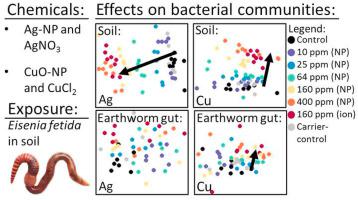Environmental Pollution ( IF 8.9 ) Pub Date : 2020-09-18 , DOI: 10.1016/j.envpol.2020.115633 Elmer Swart , Tim Goodall , Peter Kille , David J. Spurgeon , Claus Svendsen

|
Environmental pollution can disrupt the interactions between animals and their symbiotic bacteria, which can lead to adverse effects on the host even in the absence of direct chemical toxicity. It is therefore crucial to understand how environmental pollutants affect animal microbiomes, especially for those chemicals that are designed to target microbes. Here, we study the effects of two biocidal nanoparticles (NPs) (Ag and CuO) on the soil bacterial community and the resident gut microbiome of the earthworm Eisenia fetida over a 28-day period using metabarcoding techniques. Exposures to NPs were conducted following OECD test guidelines and effects on earthworm reproduction and juvenile biomass were additionally recorded in order to compare effects on the host to effects on microbiomes. By employing a full concentration series, we were able to link pollutants to microbiome effects in high resolution. Multivariate analysis, differential abundance analysis and species sensitivity distribution analysis showed that Ag-NPs are more toxic to soil bacteria than CuO-NPs. In contrast to the strong effects of CuO-NPs and Ag-NPs on the soil bacterial community, the earthworm gut microbiome is largely resilient to exposure to biocidal NPs. Despite this buffering effect, CuO-NPs did negatively affect the relative abundance of some earthworm symbionts, including ‘Candidatus Lumbricincola’. Changes in the soil bacterial community and the earthworm microbiome occur at total copper concentrations often found or modelled to occur in agricultural fields, demonstrating that soil bacterial communities and individual taxa in the earthworm microbiome may be at risk from environmental copper exposure including in nanomaterial form.
中文翻译:

micro微生物组对暴露于杀生物金属纳米颗粒具有抵抗力
环境污染会破坏动物及其共生细菌之间的相互作用,甚至在没有直接化学毒性的情况下也可能对宿主产生不利影响。因此,至关重要的是要了解环境污染物如何影响动物微生物群落,特别是对于那些旨在针对微生物的化学物质。在这里,我们研究了两种杀生物纳米颗粒(NPs)(Ag和CuO)对soil Eisenia fetida的土壤细菌群落和肠道微生物组的影响使用元条形码技术在28天的时间内。根据OECD测试指南进行NP暴露,并另外记录对recorded繁殖和幼生物量的影响,以便比较对宿主的影响与对微生物群落的影响。通过采用全浓度系列,我们能够以高分辨率将污染物与微生物组效应联系起来。多变量分析,微分丰度分析和物种敏感性分布分析表明,Ag-NPs对土壤细菌的毒性比CuO-NPs大。与CuO-NP和Ag-NP对土壤细菌群落的强大作用相反,worm肠道微生物组在暴露于杀生物NP时具有很大的适应性。尽管有这种缓冲作用,但是CuO-NPs确实会对某些earth共生体的相对丰度产生负面影响,包括Candidatus Lumbricincola'。土壤细菌群落和the微生物组的变化发生在农田中经常发现或模拟的总铜浓度下,这表明worm微生物组中的土壤细菌群落和单个分类群可能受到环境铜暴露(包括纳米材料形式)的威胁。


























 京公网安备 11010802027423号
京公网安备 11010802027423号